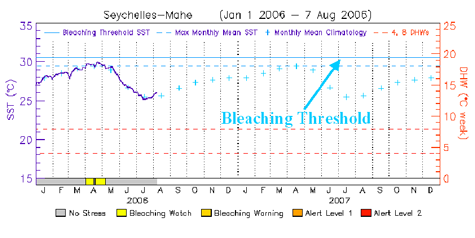|
|
The "bleaching threshold" concept is crucial for understanding the Coral Reef Watch products, and we find that it is often misunderstood. This entire section will focus, therefore, on a careful definition of this concept, before we delve further into the 50km data products. You will remember from the coral bleaching section that corals are very sensitive to warm temperatures. To look for areas at risk for bleaching, we would start by looking for places that are warmer than normal -- i.e., places with a positive SST Anomaly. But it turns out that we can be even more specific than that. Scientists have shown that corals start to become stressed when the SST is 1°C warmer than the highest monthly mean temperature (Glynn and D'Croz, 1990). Let's look again at one of the 50km Virtual Station time series graphs to see what this "maximum monthly mean" (MMM) concept means. 
The light-blue crosses represent the mean temperature for each month. Now we need to look for the warmest month in the seasonal cycle. For the Seychelles example above, the mean temperature reaches a maximum of 29.5°C in April. So for this coral reef site, the MMM is 29.5°C (shown as a light-blue horizontal dashed line). One degree above the MMM is called the "bleaching threshold" temperature. The bleaching threshold is shown on our 50km Virtual Station time series graphs as a solid light blue horizontal line: 
When the SST is warmer than the bleaching threshold temperature, the corals will experience heat stress. This heat stress is the main cause of mass coral bleaching.
|
|
||||||||||
|
|
||||||||||||
|
IMPORTANT USER ALERT (2 July 2024): This past weekend, a storage server at NOAA's Center for Satellite Applications and Research, which delivers the NOAA Coral Reef Watch data, suffered a hardware failure. The issue is being addressed, and we hope to have the NOAA Coral Reef Watch data back up and running as soon as possible. (1) The most recent data will be made available first; historical data may take time to be restored. (2) If you need specific data that are not yet available, please contact us at coralreefwatch@noaa.gov. (3) If you use code to pull data, please revise your code to use “…/socd/…” in lieu of “…/sod/…” in all relevant web addresses for all future needs. We apologize for any inconvenience this may cause. |